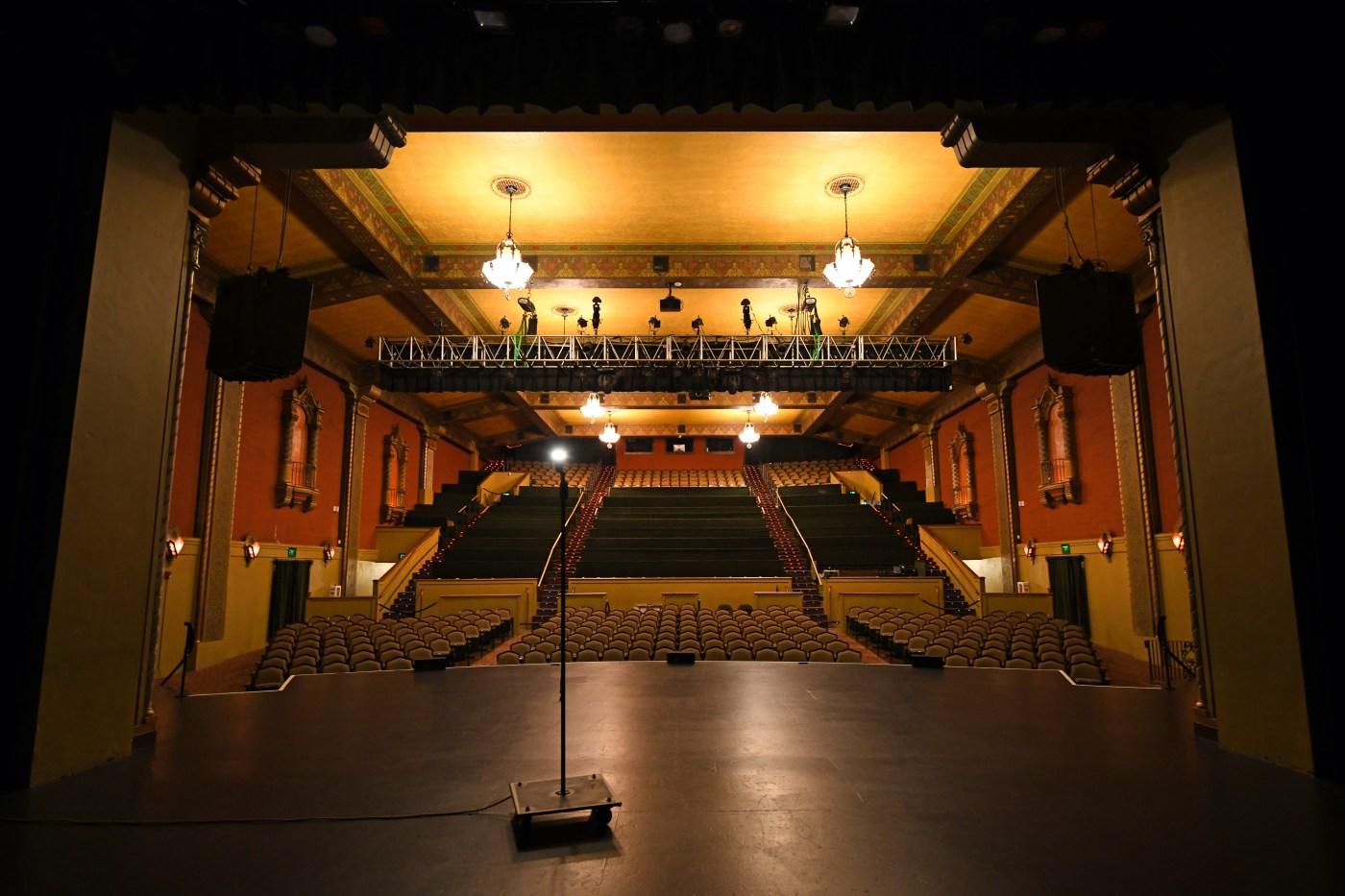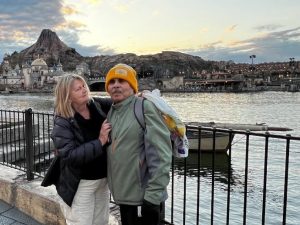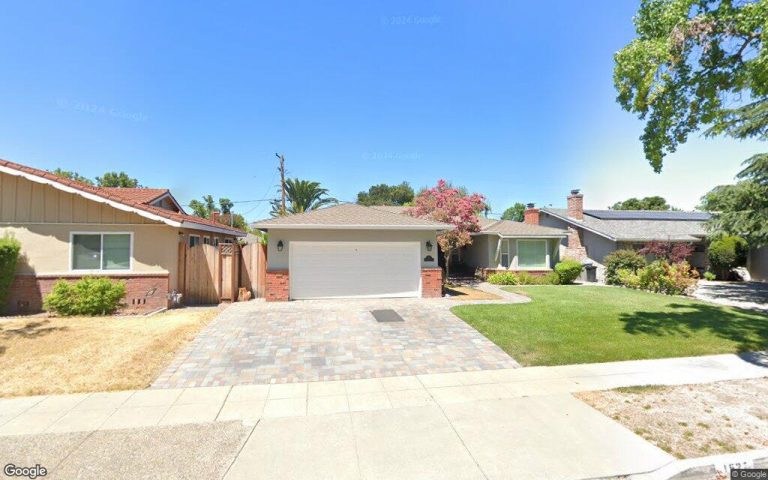Long ago, Bay Area residents left their homes to be entertained. Before TV, record players or even radio, the local concert hall was the place to see vaudeville or grand opera, popular touring bands, famous singers or silent movies accompanied by the music of a live organ.
By the early 1900s, nearly every Bay Area enclave had its own live performance space. Some of these venues felt like small palaces, as splendid as the finest big-city opera house. Others began as neighborhood clubs or community halls, before evolving into beloved destinations for arts and culture.
Several of these historic theaters still operate as entertainment venues, the pride of their Main Streets, even if the nature of the entertainment has changed. They also serve as a reminder that, even in this siloed, streaming age, people still want to come together and see a show in an inviting place. Here are nine of these gems.
California Theatre, San Jose
She’s the grande dame of San Jose’s cultural scene, a 1927 star who experienced many fallow years later in the century before returning to prominence, her neon “CALIFORNIA” sign again towering over downtown’s South First Street.
The opulent 1,100-seat theater is the home of Opera San Jose and the Symphony San Jose and plays host annually to the Cinequest Film Festival, with organist Dennis James playing silent film scores on the mighty Wurlitzer.
The California Theatre in downtown San Jose, Calif., on Sunday, March 17, 2024. (Nhat V. Meyer/Bay Area News Group)
That the building was restored to its original magnificence is an almost unbelievable story. The California languished for nearly three decades after its closure in 1973. The San Jose Redevelopment Agency purchased the site in 1985 but struggled for years to find funding for the massive project. In the end, the property tax-funded agency paid two-thirds of the $75 million tab and philanthropist David Packard contributed one-third through his Packard Humanities Institute, along with his personal design oversight.
The three-year renovation culminated in a grand reopening in 2004. Opera San Jose, founded by the globally renowned Irene Dalis, who had watched movies here as a child, presented Mozart’s “The Marriage of Figaro.”
Kudos for the gorgeous renovation came from all corners. Calling it a “masterpiece,” a Mercury News editorial noted, “The California brings new hope to downtown.” Alan Hess, who wrote architectural reviews for the paper, raved about the painstaking attention to the Spanish Renaissance facade, the “ingenious” interior design work by Berkeley architects ELS and their “sensitivity to the original aesthetic.”
“All this effort was bestowed on the right structure,” Hess wrote. “In 1927, this movie and vaudeville theater by architects Weeks and Day rivaled anything found in San Francisco and much of Los Angeles. These grand movie palaces inspired by the relatively new technology of the movies offered the average citizen an evening in a palace.”
Now nearly a century old, the California offers that palatial experience scores of nights a year.
Shows coming up: Opera San Jose’s first Spanish language work, the Bay Area premiere of Mexican composer Daniel Catan’s “Florencia en el Amazonas,” April 28-May 5; Symphony San Jose’s “Passionate Puccini,” May 11-12; and Sofia Niño de Rivera, a noted Mexican stand-up comedian and actress, May 17. https://sanjosetheaters.org
The Pittsburg California Theatre and the El Campanil, Antioch
After these neighboring East Contra Costa County cities transitioned from Delta farming communities to thriving centers of industry, enterprising locals worked to bring culture to their booming downtowns.
In Pittsburg in 1920, local entertainment moguls Sylvester and Salvatore Enea opened the California Theatre, one of several they would go on to operate in the area. They promoted the theater as a premiere venue for vaudeville shows and silent films, with architect A.W. Cornelius designing the theater in the classical revival style, fronted with sculptures and Corinthian columns.
The California Theatre in Pittsburg was built in 1920 as a venue for live vaudeville performances and silent films. (Jose Carlos Fajardo/Bay Area News Group)
Related Articles
Review: ‘A Strange Loop’ is a lively, engrossing head trip in West Coast premiere
7 amazing Bay Area things to do this weekend
Bay Area arts: 8 cool shows and concerts to catch this weekend
‘Strange Loop,’ the improbable Broadway sensation, opens in SF
Berkeley Rep’s new season: From Mexican underground railroad to a Holocaust mystery
Eight years later, a news report announced that “the most pretentious building in Contra Costa County” had opened in Antioch. Perhaps that was a compliment in the Roaring ’20s, because El Campanil is notable for the elegance of its ornate Spanish Colonial facade, topped by a bell tower for which it was named. El Campanil owners Ferdinand Stamm and Ralph Beede booked touring vaudeville acts and silent films for the new venue.
Early patrons at both theaters paid just 25 cents for general admission, and they still enjoyed an elegant night out in the plush seats of auditoriums graced with elaborate murals and chandeliers. Over the decades, the theaters also brought popular national touring acts to East Contra Costa, with El Campanil playing host to Mary Pickford, Roy Rogers and Donald O’Connor. El Campanil also found a unique way to track its history. Anyone who performed on its stage was invited to leave their autograph on a wall in the green room or men’s and ladies’ dressing rooms.
Over time, the theaters began to struggle, due to evolving tastes in entertainment and the changing fortunes of downtowns. The California showed its last movie in 1954 and subsequently fell into disrepair. El Campanil hung in longer. But at one point, it was used by a church group that supposedly so objected to holding services on a stage beneath a mural depicting two nude women that the artwork was painted over.
Near the turn of the 21st century, city leaders and arts lovers in both cities realized that putting their historic theaters back to work could bring residents back downtown. Each town raised millions to rehab pipe organs and refurbish light fixtures and decor, restoring a mural of two winged nymphs dancing alongside the stage at the California Theatre and the two nudes who caused such a fuss at El Campanil. The Antioch and Pittsburg theaters reopened in 2004 and 2014, respectively, and have staged hundreds of concerts, plays, comedy acts and community events each year since.
And those backstage autographs can still be seen at El Campanil, including a signature by Debbie Reynolds, who performed at El Campanil’s gala reopening.
You can still see Debbie Reynolds’ autograph on the wall of a dressing room at Antioch’s El Campanil Theatre. (Aric Crabb/Bay Area News Group)
Shows coming up: At El Campanil, catch ZZ Tush’s tribute to ZZ Top on May 3; Forejour, the Foreigner and Journey tribute band, on May 25; and “The ‘Phantom’ Returns: Franc D’Ambrosio in Concert” on June 9; www.elcampaniltheatre.com. At the California Theatre, Pittsburg Theatre Company’s “Willy Wonka” hits the stage on May 4; https://pittsburgcaliforniatheatre.com.
Guild Theatre, Menlo Park
This concert hall is a recent success story, one that gladdens the hearts of preservationists and longtime Peninsula residents when they drive by on El Camino Real — particularly because a nearby vintage theater, the Park, was demolished a decade ago.
The eldest of the two, this theater was called the Menlo when it made its debut in May 1926. Designed in the Streamline Moderne style of the day, the theater hosted burlesque shows and showed movies in the early years, according to the Cinema Treasures website.
In March 1948, the Menlo reopened for movies only as the Guild, with David Lean’s adaptation of playwright Noel Coward’s “This Happy Breed” christening the big screen. Articles and ads in the the Palo Alto Times trumpeted the “abstract” decor, a live flower garden in the foyer and state-of-the-art projection and sound systems. “It will be operated strictly for the pleasure of those who enjoy only the finest in film fare, and for those who have lost interest in the usual run of pictures,” the owners said. “The Guild will be the foreign-language headquarters, theatrically, on the Peninsula.”
And for decades that was the case, with independent and foreign language films playing here along with top motion pictures until 2019, when the theater’s 93-year run came to an end.
The Peninsula Arts Guild had already entered the picture. This nonprofit with a mission to develop a live-music venue in 650 land embarked on an ambitious, $35 million renovation that includes some vintage art deco pieces.
The Guild reopened in 2022 — again, state of the art — to feature both “little bitty bands that nobody has heard of” and “stadium acts” for 500 audience members, the group’s president, Drew Dunlevie, said at the time.
The theater is heavily booked and drawing well. “We did 174 shows/events in 2023, and we’re looking at 200-plus in 2024,” general manager Tom Bailey said.
Shows coming up: Grahame Lesh & Friends with special guest Stu Allen, May 3; Susto Stringband, May 17; Stephen Marley, May 27; Ryan Adams, June 7 and 8; www.guildtheatre.com
Littlefield Concert Hall, Mills College at Northeastern University, Oakland
Built in 1928, Littlefield Concert Hall swiftly became “ground zero” for 20th-century music innovation, a place where “the future of music arrived first,” according to one music critic.
Over its nearly 100-year history, the hall provided a performance space for a music department with an outsize influence on contemporary music. It boasts a long list of faculty and students who pioneered new sounds and practices in classical music, jazz, world and electronic music and rock. A short list includes Darius Milhaud, Henry Cowell, Lou Harrison, John Cage, Pauline Oliveros, Maggi Payne, Dave Brubeck, Laurie Anderson and Roscoe Mitchell. The hall also hosted historic performances by such luminaries as Igor Stravinsky, Nadia Boulanger and the Pro Arte, Budapest and Kronos string quartets.
Littlefield Concert Hall at Mills College on June 11, 2022. Photo by Ruby Wallau for Northeastern University
The gracious Spanish Colonial facade and entrance framed by medieval, Renaissance and Baroque statuary introduce visitors to the eclectic vision of English-born architect Walter Ratcliff Jr. Inside the 450-seat auditorium, Depression-era painter Raymond Boynton created boldly colorful ornamental ceilings and fantastical murals and frescoes inspired by ancient mythology, musical motifs, California history and the state’s natural beauty. Boynton said his goal was “to give free play to the imagination and, through color and rhythm and formality, heighten that mood in the listener.” David Bernstein, the former music department head, called the hall the “visual embodiment of the spirit of the experimentalism” that was cultivated at Mills.
During an extensive 18-month renovation in the late 2000s, old and damaged wall tiles were replaced with elegant new acoustic panels that enhanced the hall’s sound. Alas, Mills’ music department closed after financial challenges forced the campus to merge with Boston-based Northeastern University in 2022. Bernstein said it’s not certain what the future holds, but Littlefield Hall still hosts a concert series that allows people to experience music in a beautiful, uplifting setting.
Upcoming shows: Find concert listings at https://performingarts.mills.edu.
Campbell Heritage Theatre, Campbell
Students who attended Campbell Union High School decades ago performed on the stage of what had to have been one of the most impressive school auditoriums in the state, if not the country.
Now restored as a concert hall, the auditorium and two other campus buildings are considered rare examples of Spanish Colonial Revival style architecture constructed by the 1930s Works Progress Administration, the New Deal program that employed Americans to build public works projects.
Credit goes to noted (and prolific) California architect William H. Weeks, who designed hundreds of banks, schools and Carnegie libraries throughout the state — along with the Cocoanut Grove in Santa Cruz and the De Anza Hotel in San Jose — in the early decades of the 20th century.
The high school closed in 1980, and the site was turned over to the city. “The theater was shut down in 1982 due to structural concerns and the once-great cultural resource was ‘dark’ for 20 years,” a city history said. Demolition of the 1938 building was in the works, until a group of citizens rallied, formed the Friends of the Heritage Theatre, incorporated in 1998 and set about raising renovation funds.
In 2004, the refurbished and renamed Campbell Heritage Theatre — “Campbell’s crown jewel” — was reintroduced to the South Bay at a champagne gala featuring entertainer Tommy Tune and the Manhattan Rhythm Kings.
Today, the Heritage hosts events year-round. And the friends group is still around to ensure that it remains a state-of-the-art venue.
Shows coming up: Mavis Staples’ 20th anniversary show, May 10; “Sleeping Beauty” by the Academy of Classical Ballet, May 18-19; Peninsula Symphony Orchestra with pianist Jon Kimura Parker, May 24; “Late Nite Catechism,” June 9; Benise Fiesta, Oct. 6; Nick Carter, Nov. 22. www.campbellca.gov/353/Heritage-Theatre
Hillside Club, Berkeley
On a rainy February evening, guitarist Bruce Victor and mandolinist Marla Fibish finish a preshow sound check for Noctambule, a duo that performs traditional Irish music and their own songs. Their voices carry like bells through an auditorium known for its acoustic resonance and unique setting.
The Hillside Club began as a private social club for women in the late 1800s. The clubhouse was built in 1906 after membership expanded to include prominent local men, including architect Bernard Maybeck, who designed the building in his signature Arts and Crafts aesthetic. But 17 years later, a devastating fire swept out of Wildcat Canyon and destroyed the clubhouse and more than 600 other structures north of the UC Berkeley campus, including Maybeck’s home. The overwhelmed architect told the club to ask his brother-in-law and acolyte John White to design the clubhouse replacement.
Berkeley’s Hillside Club was founded in 1898 with a design by famed architect Bernard Maybeck. (Aric Crabb/Bay Area News Group)
White kept the Arts and Crafts architecture but added an expanded stage and auditorium to reflect the club’s increased focus on the performing arts. Carved wooden beams and tall casement windows grace the interior, and a stained-glass window depicts a sunny coastal scene of redwoods, ocean and blue sky.
The club’s membership has waxed and waned over the decades, but new energy arrived in the 2000s, according to past president Jim Fisher. New members with eclectic artistic tastes as well as sound-technology expertise worked to make the club into what music critic Andrew Gilbert has called a “vital outpost” for local and regional musicians seeking to perform in intimate settings. The club hosts a regular slate of classical, jazz and folk music as well as opera, including the Pocket Opera company’s recent chamber production of Rossini’s “La Cenerentola.”
Shows coming up: A Mother’s Day matinee of bluegrass and classical music by Tristan Scroggins and Alisa Rose May 12; www.hillsideclub.org.
Fox Theatre, Redwood City
Talk about impressive pedigrees. This concert hall set in the heart of downtown is part of the architectural legacy of the famed Reid & Reid company, formed by two brothers who moved from Indiana to the West Coast. They’re known for designing such landmarks as the Hotel del Coronado (1888), San Francisco’s Fairmont Hotel (1907) and the 1909 iteration of the Cliff House.
In the 1920s, they designed many Northern California movie theaters, among them the Alexandria and the Balboa in S.F., the Golden State in Monterey and the Grand Lake in Oakland.
And then Redwood City. This movie palace made its debut just after New Year’s in 1929 as the Sequoia Theatre but was purchased some months later by the Fox company, according to the theater’s website.
A four-month renovation took place in 1950, but there are vestiges from the 1920s. “Much of the interior is original, including the beautiful murals,” general manager Ernie Schmidt said. “We even have the working water fountain dating back to 1929.”
In the years since live performances started, the Fox has hosted entertainers including Art Garfunkel, the Beach Boys, Air Supply, Merle Haggard and Tom Jones and comedians Joan Rivers, Dana Carvey and Jason Alexander, and such luminaries as President Obama.
Shows coming up: Egyptian pop star Ahmad Saad, May 4; “One of Those Nights: The Songs of the Eagles,” May 11; Odette Quesada, 40th anniversary celebration concert, May 12; “The Concert of Kings,” June 22; ABBAMania and Night Fever, June 29; “The Sweet Caroline Tour” starring Jay White, Oct. 12. https://foxrwc.com/
Lafayette Town Hall Theatre
For 110 years, this 185-seat theater has always been a community effort. Lafayette residents donated the land and $200 towards the costs of putting up the original shingled structure, and in the decades since, locals have come through with funds to bring the theater up to fire code and upgrade the stage, seats and lighting. Often, they do the labor themselves.
Lafayette’s Town Hall Theatre was built in 1914. (Ray Chavez/Bay Area News Group)
Related Articles
Review: ‘A Strange Loop’ is a lively, engrossing head trip in West Coast premiere
7 amazing Bay Area things to do this weekend
Bay Area arts: 8 cool shows and concerts to catch this weekend
‘Strange Loop,’ the improbable Broadway sensation, opens in SF
Berkeley Rep’s new season: From Mexican underground railroad to a Holocaust mystery
“Then, as now, we rely on the efforts of the community,” said Dennis Markam, the theater’s managing director. “We (just) had volunteers from the National Charity League here, helping us paint things and reorganize our backstage.”
The theater was never an actual town hall, but it was always a nexus, providing space for whatever was needed in a mostly rural community. It hosted dances, meetings, church services, a library, a nursery school and even basketball games. It opened in 1914 in grand fashion with a ball that attracted hundreds of revelers from across the East Bay, who traveled to Lafayette by the old Oakland-Antioch & Eastern Railway. Because the dance started fashionably late at 9 p.m., a special train was brought in to transport people home in the early morning hours.
After the United States joined World War II, the hall briefly housed soldiers, according to Markam.
But the hall became a performing arts venue, and a theater troupe, the Dramateurs, began staging productions there. The Dramateurs reorganized as the Town Hall Theatre Company in 1992 and has presented a season of around four plays every year since, save during lockdown in 2020.
Memorial plaques are embedded in the armrests at Lafayette Town Hall Theatre. (Ray Chavez/Bay Area News Group)
The company, which took over building ownership in 2021, offers theater classes and welcomes other local arts groups. Among them: Front Porch Open Mic, a group of singers and musicians who organized front porch concerts of folks, bluegrass, country and blues during the pandemic. Now they do a regular slate of performances at Town Hall.
Shows coming up: “Yes, and Wine! Adult Improv” on May 19; www.townhalltheatre.com












